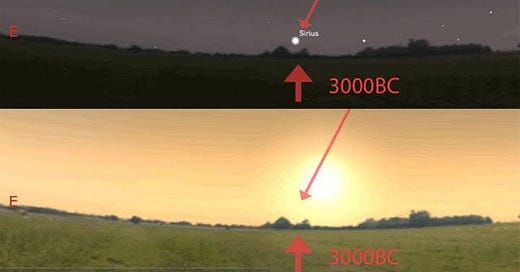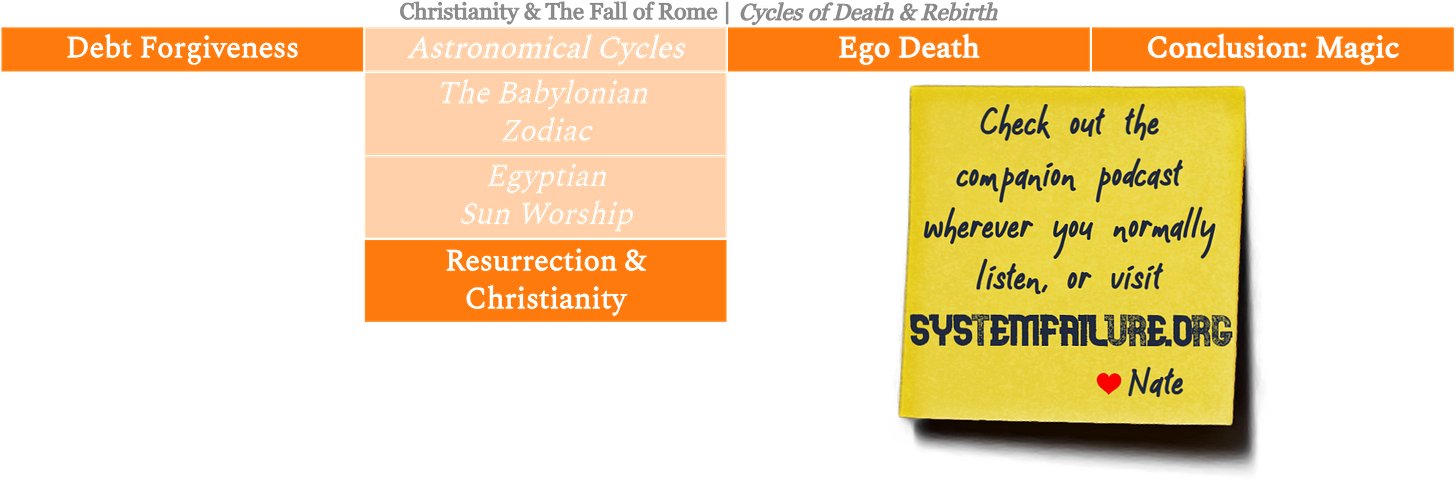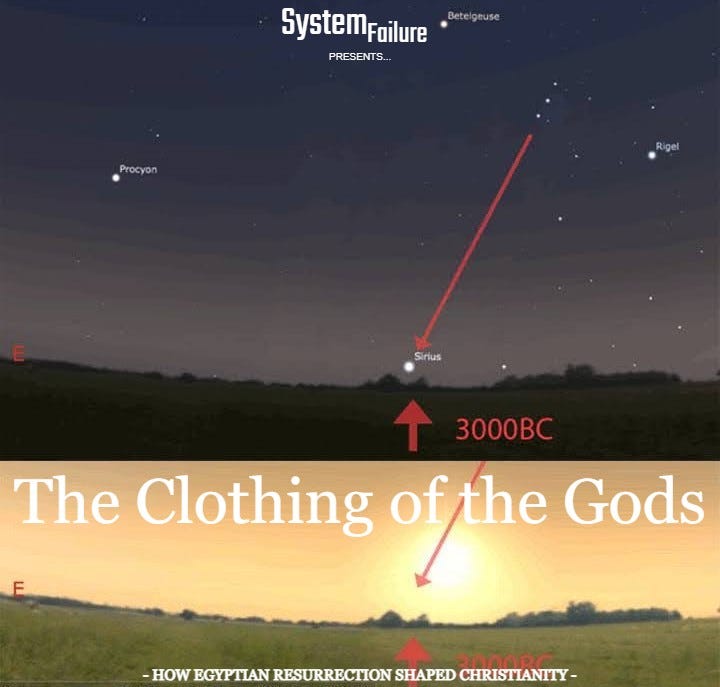Death and rebirth are central themes of Christianity, both in its mythology—the story of Jesus is about coming back from the dead—and in its actual history. Christianity resurrected dead and dying older traditions and carried them forward into the Middle Ages and beyond.
Three major examples—all readily allegorized by death and rebirth—are debt forgiveness, astronomical cycles, and ego death. These are the three main layers of Christian source material.
Daily and annual astronomical cycles cause alternating day and night and the rhythms of the agricultural growing seasons. Because early Neolithic farmers so obviously owed their lives to the sun's comings and goings, they understandably worshipped it as their daily and annual savior.
Symbols of sun worship were incorporated into Christianity because they were broadly recognizable to the pagan world into which Christianity was born. The Babylonian and Egyptian religions were both based on astronomy, and early Christians borrowed heavily from them. That’s how astronomical cycles shaped Christianity as we recognize it today.
Syncretism
Syncretism is the idea that the gods change cultures like we change clothes. The ebb and flow of religious traditions over the millennia has a democratic element. Spiritual beliefs are too deeply ingrained to be imposed from above; conquering armies find that violent repression only guarantees fierce resistance. Therefore, adopting new religious beliefs is a quasi-democratic compromise between power and tradition.
For example, the Greek gods Zeus and Aphrodite became the Roman Jupiter and Venus. After the Roman conquest of Greece in the 2nd century BC, it was as if these gods abandoned Greek society, packed up, and moved to Rome. The Roman state religion was flexible and pragmatic, often incorporating gods from conquered peoples. It was the only way to unify diverse cultures within the Empire.
When applied to Christianity, syncretism is known as the Pagan Continuity Hypothesis. During the Medieval period, the Roman Catholic Church resisted the idea that its story was assembled from existing parts. Church fathers bolstered their own authority by portraying their faith as a direct revelation from God, not a syncretic milieu of existing traditions.
However, the syncretic nature of Christianity makes it far more ancient than the Roman Empire. Augmented by thousands of years of existing tradition, it’s just the latest mask worn by a vast cross-section of ancient traditions. Ideas people don’t find relevant to their lives are forgotten, while helpful ideas are remembered and passed on. This process of Darwinian evolution honed and smoothed the suite of ideas contained within Christianity into a key that fits many locks. Its resurrection allegory borrows much from older traditions of sun worship, but death and rebirth are eternal themes that cut to the heart of what it means to be human.
Agriculture & Astronomy
It wouldn’t be accurate to say that, during nights and winters, early Neolithic farmers were terrified that the sun might not return in the morning or spring. It was almost as easy to take the sun for granted then as now. One significant difference is that we have a working solar system model available to comfort us; its cyclical nature is self-evident. But for the ancients, the reason why the sun always returns to us was an enduring mystery.
Early agrarian societies so obviously owed their livelihoods to the sun's daily and annual astronomical cycles—and the annual growing seasons they cause—that they came to associate the sun's return with salvation. Furthermore, the ancient Egyptians conceptualized the sun's yearly death and rebirth as a resurrection.
Christmas
When taken together, the annual Christian holidays of Christmas and Easter reflect the same yearly cycle of death and rebirth. Unsurprisingly, the familiar elements of these celebrations were adopted from older traditions of sun worship in the Mediterranean Basin.
The sun gradually appears less and less in the skies of the Northern Hemisphere each fall. In December, that rate of disappearance finally slows to stop. After three days, it reverses course and begins appearing more and more each day throughout the spring. This turning point is the Winter Solstice; the middle day is the shortest day of each year in the Northern Hemisphere.
The title card for this essay contains images of the skies some 5,000 years ago, generated by stellarium-web.org. These images depict the sky over Tel Aviv on the nights of December 23 and 24. In the evening, the three stars of Orion’s belt point directly at the brightest star in the night sky, Sirius, as it rose over the horizon.
The following morning, on the Winter Solstice, the sun rose in the same spot on the horizon occupied by Sirius the night before. For this reason, sun gods like the Egyptian Horus, the Persian Mithras, and the Roman Sol Invictus were all said to have been born on the Winter Solstice.
In addition, the births of these sun gods were each attended by three significant figures, which correspond to the three stars of Orion’s belt. Such was the case with the Egyptian sun god Horus. In the Christian tradition, these figures became the three wise men who followed a bright star to arrive at the birth of Jesus. The story of Jesus inherited these and other astrological allegories from existing traditions of sun worship. His death and resurrection also fit that pattern.
Easter
One of the most significant dates on the ancient Egyptian calendar was their New Year celebration. It coincided with the annual flooding of the Nile delta and the heliacal rising of Sirius, the brightest star in the night sky. Because the return of those floodwaters heralded the regrowth of the agricultural crops that fed Egypt, the major themes of this occasion were rebirth and regeneration. For Egyptians, the story of the death and resurrection of their god Osiris allegorized the annual deliverance of the flood.
Later, the Christian church adopted this allegory of resurrection. Christians today celebrate the death and resurrection of their god in the springtime. Most are unaware of Easter's astrological origins. But Jesus’ birth on the Winter Solstice, his death in the spring, and his resurrection on the third day are all elements borrowed from previous traditions of sun worship.
Resurrection
The way the sun regularly disappears and reappears makes it the most obvious symbol for resurrection in the natural world. But astronomical symbology is just one layer of meaning in the Christian allegory of death and rebirth. There are at least two other major layers:
The first is debt forgiveness. Finance is a critical tool for the expansion of any civilization. In early agrarian societies, seeds had to be loaned out to new farmers before they could harvest their first crop. But early Neolithic creditors realized they could grow much wealthier by demanding collateral before they made a loan and then seizing collateralized property when an inevitable war, flood, or famine rendered agricultral debts unpayable. Therefore, the kings of early agrarian societies regularly forgave debts to stave off the ever-present threat of terminal wealth concentration. In those days, people were pledged as collateral as often as land. For someone experiencing debt slavery because of a default, debt forgiveness would undoubtedly have seemed like a fresh start or a rebirth.
The second is ego death. The Greeks and Romans had several distinct traditions of drug-induced ego death that were significant influences on Christianity. The kykeon of Demeter and the wine of Dionysus are two examples that live on as the bread and wine of the Christian eucharist. Psychoactive compounds used in the worship of those gods chemically induce a collapse in the mental conception of oneself. The resulting experience is both harrowing and highly informative; it feels exactly like a death and rebirth…
Further Materials
A religious symbol conveys its message even if it is no longer consciously understood in every part. For a symbol speaks to the whole human being and not only to the intelligence.
-Mircea Eliade, The Sacred And The Profane, 1957, page 129







Funny I should read this today, my girls are reading about the Persians at the moment, and they have a very similar story to the Jesus story.
It's been an interesting experience teaching the girls all these Greek, Roman, Egyptian gods and all the similarities that run through it, especially as we're in one of the most Catholic countries in the world and have had to resist their indoctrination from family members since birth!
Today's horoscope matches the zodiac 2,000 years ago. Back then the sun was in Virgo in September, which meant that Virgo reappeared in the night sky in December. Nine months before the winter solstice is the vernal equinox, named for Venus, the goddess of pregnancy.